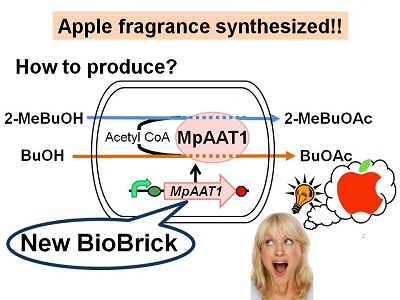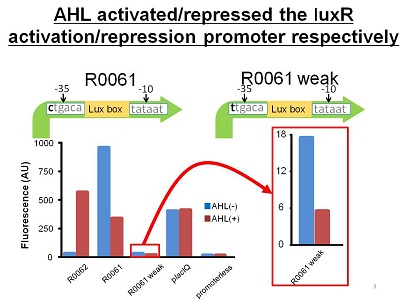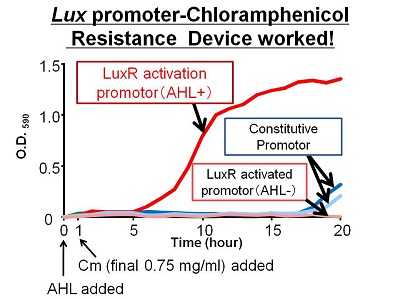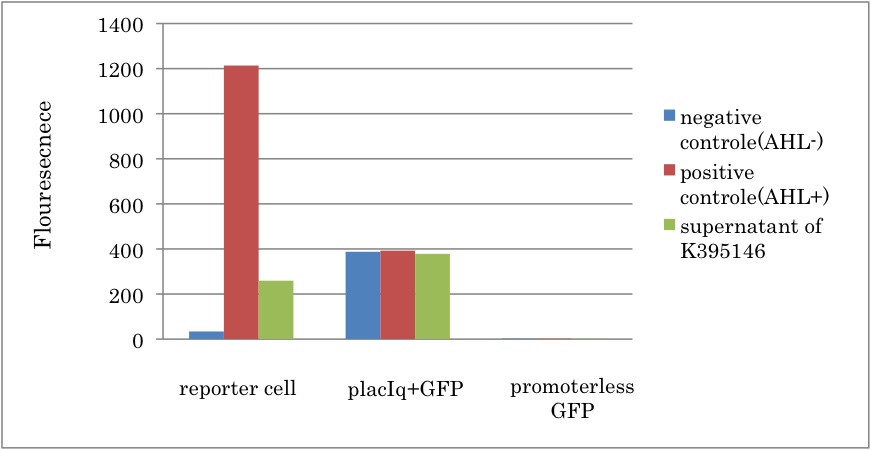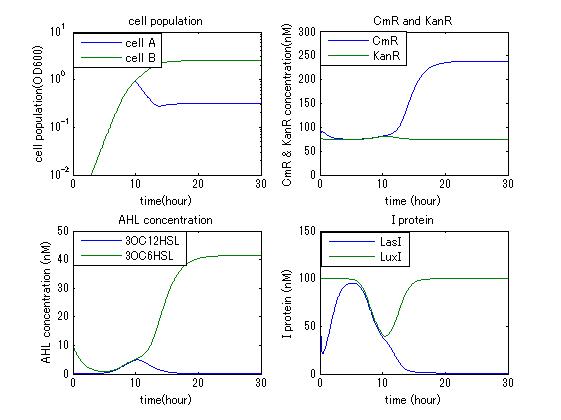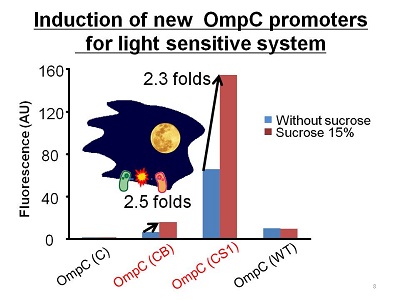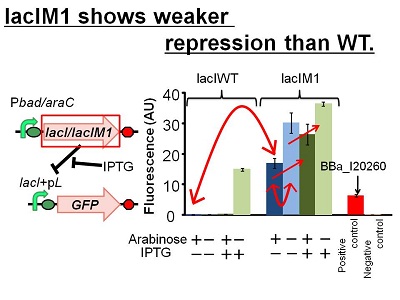Team:Tokyo Tech
From 2010.igem.org
| (102 intermediate revisions not shown) | |||
| Line 1: | Line 1: | ||
| - | |||
{{Tokyo_Tech_Template2}} | {{Tokyo_Tech_Template2}} | ||
| - | |||
| - | |||
<div id="super_main_wrapper"> | <div id="super_main_wrapper"> | ||
| - | <div id="tf_menu"> | + | <div id="tf_menu"> |
| - | < | + | <font size="5" color="#eb8300"><b><center>Project menu</center></b></font> |
| - | <tr><th> | + | |
| - | + | <center> | |
| - | + | <table id="table-01"> | |
| - | <tr><td>< | + | <tr> |
| - | < | + | <th>1 Graphic abstract -YOU ARE HERE!- <br> |
| - | </ | + | </th> |
| - | </div> <!-- | + | </tr> |
| + | <td>2 Apple reporter<br> | ||
| + | :[[Team:Tokyo_Tech/Project/Apple_Reporter|2-1 Color]] | ||
| + | :[[Team:Tokyo_Tech/Project/Apple_Reporter2|2-2 Fragrance]] | ||
| + | </td> | ||
| + | <tr> | ||
| + | <td>[[Team:Tokyo_Tech/Project/Artificial_Cooperation_System|3 Artificial Cooperation System]]<br> | ||
| + | :[[Team:Tokyo_Tech/Project/Artificial_Cooperation_System/lux_act_rep|3-1 lux activation/repression promoter]] | ||
| + | :[[Team:Tokyo_Tech/Project/Artificial_Cooperation_System/Cm_assay|3-2 resistance gene activation device]] | ||
| + | :[[Team:Tokyo_Tech/Project/Artificial_Cooperation_System/luxI_assay|3-3 ''lux''I Assay]] | ||
| + | :[[Team:Tokyo_Tech/Project/Artificial_Cooperation_System/modeling|3-4 modeling]] | ||
| + | </td> | ||
| + | </tr> | ||
| + | <tr> | ||
| + | <td>[[Team:Tokyo_Tech/Project/wolf_coli|4 Wolf coli overview]]<br> | ||
| + | :[[Team:Tokyo_Tech/Project/wolf_coli/New_Series_of_PompC|4-1 New series of P''ompC'']] | ||
| + | :[[Team:Tokyo_Tech/Project/wolf_coli/lacIM1|4-2 lacIM1 for band-detect network]] | ||
| + | :[[Team:Tokyo_Tech/Project/wolf_coli/System|4-3 Wolf coli system]] | ||
| + | </td> | ||
| + | </tr> | ||
| + | </table> | ||
| + | </center> | ||
| + | |||
| + | <font size="3" color="#eb8300"><b> | ||
| + | We won the track award, the Best Information Processing Project.<br> | ||
| + | We also won the Gold Medal<br> | ||
| + | Thank you all!! | ||
| + | </b></font><br> | ||
| + | [https://igem.org/Results?year=2010 See result page] | ||
| + | |||
| + | </div> <!-- tf_menu --> | ||
<div id="tf_SubWrapper"> | <div id="tf_SubWrapper"> | ||
| - | + | <font size="5"><b>1 Graphic abstract</b></font> | |
| + | __NOTOC__ | ||
| + | [[Image:Tokyotech_top5.png|center]] | ||
| - | |||
| - | |||
| - | + | <font size="5" color="#ff8c00"><b>What do you think of humanity?</b></font><br> | |
| - | |||
| - | |||
| - | + | This is a common question that human beings have long sought to answer. And answer may vary. | |
| - | + | According to LONGMAN dictionary, humanity refers to, | |
| + | <blockquote>“the state of being human rather than an animal or machine. For example, kindness, respect and sympathy towards others.”</blockquote> | ||
| - | + | In the age of science and technology, people are getting more and more involved in their own business. Meanwhile, the society they are connected with is becoming limited to only a small group of people consisting their family and work partners. Moreover, their concerns are becoming more personal and less global.<br> | |
| - | + | In other words, humanity is losing its position in human life. | |
| - | + | ||
| - | |||
| - | + | <font size="4" color="#005396">Tokyo_Tech team has put its effort on producing E.coli with humanity,</font><br>hoping this to be awakening call for all of those who are forgetting their state of being human…. | |
| - | + | ||
| - | |||
| - | |||
| - | + | <h2>1. Concept -''E. coli'' with humanity-</h2><br> | |
| + | In order to make ''E. coli'' with humanity, we decided to engineer ''E. coli'' that can communicate with other, recognize the crisis situation other might be facing and show its sympathy toward it by rescuing it from dying...<br> | ||
| + | Below we pictured our desired behavior of ''E. coli'' with humanity. Two kinds of cells are assumed. In normal conditions, they are competitors for survival because they are grown together in a single medium where the growing resources are limited. While in crisis conditions, such that one is dying, another cell would notice the crisis of dying cell and rescue it. The recovered cell appreciates the help by producing “apples”. | ||
| - | + | [[Image:Tokyotech_manga.jpg|center|640px|thumb|fig.1-1 1.They are competitors. 2.One is dying, another cell notices it. 3.Fine cell rescues dying cell. 4.Dying cell recovers and she gives "Apples" as expression of appreciation]] | |
| - | + | ||
| - | + | ||
| - | </ | + | <h2>2. Apple reporters</h2><br> |
| + | Our ''E. coli'' with humanity gives “apples” as expression of appreciation. | ||
| + | It’s really difficult to make ''E. coli'' producing real apples. However, we succeeded in synthesizing two components of apples. | ||
| + | <h3>2-1. Color -Carotenoid synthetic pathway complete!-</h3><br> | ||
| + | [[Image:tokyotech_top1.JPG|250px|right]]This year, our team expanded the project of Cambridge 2009. We succeeded in synthesizing zeaxanthin by adding crtZ into crtEBIY likewise astaxanthin by crtZW. We identified them by TLC. | ||
| + | Astaxanthin is the final metabolite of carotenoid synthetic pathway. | ||
| + | [[Team:Tokyo_Tech/Project/Apple_Reporter|(See more…)]] | ||
| - | </ | + | |
| + | |||
| + | |||
| + | |||
| + | |||
| + | |||
| + | <h3>2-2. Fragrance -We create Apple flavor in ''E. coli''-</h3><br> | ||
| + | [[Image:tokyotech_top2.JPG|250px|right]]We designed apple fragrance expression device with MpAAT1. MpAAT1 is able to produce ester compounds with apple fragrance using some alcohols and Acetyl-CoA. | ||
| + | [[Team:Tokyo_Tech/Project/Apple_Reporter2|(See more…)]] | ||
| + | |||
| + | |||
| + | |||
| + | |||
| + | |||
| + | |||
| + | |||
| + | |||
| + | |||
| + | |||
| + | <h2>3. Artificial Cooperation System</h2><br> | ||
| + | We built Artificial Cooperation System to engineer E.coli with humanity. In this system quorum sensing and chloramphenicol generator activated by LuxR are very important. | ||
| + | First, we constructed and characterized several promoters regulated by LuxR and 3OC6HSL. We designed and constructed a new LuxR repression promoter. In addition, we characterized the functions of a LuxR repression promoter and a LuxR activation promoter already existed in the registry. | ||
| + | Second, we constructed a new chloramphenicol resistance protein generator which is regulated by LuxR activation promoter. We confirmed that the cell with the chloramphenicol resistance gene generator survived in high concentration of chloramphenicol when 3OC6HSL exists. | ||
| + | Third, we confirmed the feasibility of Artificial Cooperation System from simulation and experimental data.<br> | ||
| + | [[Team:Tokyo_Tech/Project/Artificial_Cooperation_System|(See more…)]] | ||
| + | <html> | ||
| + | <center> | ||
| + | <embed | ||
| + | src="https://static.igem.org/mediawiki/2010/5/53/Tokyotech_ACS.swf" | ||
| + | width="500" | ||
| + | height="375" | ||
| + | /> | ||
| + | </center> | ||
| + | </html> | ||
| + | |||
| + | |||
| + | <h3>3-1. Lux repression promoter can work!</h3><br> | ||
| + | In Artificial Cooperation System, two types of cells use quorum sensing to recognize population of the counterpart and help one another when they are dying. The quorum sensing in this system is regulated by AHL dependent transcriptional activation/repression. Therefore, we characterized activation/repression promoters. We examined the existing LuxR repression promoter which has never been characterized before in BioBrick registry. We found that the leaky expression of this promoter is too strong to use in this system. For this reason, we constructed and characterized a new LuxR repression promoter of which strength is weaker than the existing LuxR repression promoter. | ||
| + | <br> | ||
| + | [[Team:Tokyo_Tech/Project/Artificial_Cooperation_System/lux_act_rep|(See more…)]] | ||
| + | [[Image:tokyotech_top3.JPG|250px|center]] | ||
| + | |||
| + | <h3>3-2. Antibiotic Activation Device</h3><br> | ||
| + | We succeeded in constructing and characterizing a NEW Biobrick device of chloramphenicol resistance (CmR) gene (BBa_K395162) which is activated by lux promoter. We found that the device is activated by LuxR/3OC6HSL complex and that the cell introduced the part was able to survive even in high chloramphenicol concentration (750 ug/ml) in the presence of 3OC6HSL. <br> | ||
| + | [[Team:Tokyo_Tech/Project/Artificial_Cooperation_System/Cm_assay|(See more…)]] | ||
| + | [[Image:tokyotech_top4.JPG|250px|center]] | ||
| + | |||
| + | <h3>3-3. ''luxI'' Assay</h3><br> | ||
| + | In order to test whether rbs-LuxI-ter (K092400) works correctly, we measured the amount of 3OC6HSL synthesized by LuxI generator (K395146). We confirmed that rbs-LuxI-ter (K092400) worked as expected and the amount of 3OC6HSL was sufficient to induce the chloramphenicol resistance gene expression at maximum level, which is regulated by R0062 in the Artificial Cooperation System. | ||
| + | [[Team:Tokyo_Tech/Project/Artificial_Cooperation_System/luxI_assay|(See more…)]] | ||
| + | [[Image:Tokyotech Fig.K395146-1.jpg|300px|center]] | ||
| + | |||
| + | <h3>3-4. mathematical modeling of Artificial Cooperation System</h3><br> | ||
| + | In order to confirm the feasibility of the Artificial Cooperation System, we simulated the system under typical four experimental conditions. First, when the system worked and any antibiotics did not exist, cell A and cell B in the system showed no difference of growth.<br> | ||
| + | Second, when the system did not work and chloramphenicol existed, the number of cell A decreased while the number of cell B increased.<br> | ||
| + | Third, when the system worked and chloramphenicol existed, the number of cell A increased after temporal decline, which means it was rescued by Artificial Cooperation System.<br> | ||
| + | Fourth, in the contrast, when the system worked and Kanamycin existed, the number of cell B increased after temporal decline. From the above results, the feasibility of the Artificial Cooperation System was confirmed. | ||
| + | [[Team:Tokyo_Tech/Project/Artificial_Cooperation_System/modeling|(See more…)]] | ||
| + | [[Image:Tokyotech cm sim result.jpg|250px|center]] | ||
| + | |||
| + | <h2>4. Full moon inhibits Artificial Cooperation system</h2><br> | ||
| + | Have you heard the legend of 'The Wolfman'? <br> | ||
| + | He is an ordinary man at daytime, but suddenly transforms into a ferocious wolf in the full-moon night. Our project aims to imitate the character of Wolfman. More specifically, we designed two types of ''E.coli'' that help each other to survive at daytime, whereas competing at full moon night. In order to create the “Wolfcoli”, we introduced " red-light-dependent gene expression network" and "band-detect network" and combined these networks with the Artificial Cooperation System. We characterized series of OmpC promoters and LacIM1 which are the crucial parts for our networks. | ||
| + | [[Team:Tokyo_Tech/Project/wolf_coli|(See more…)]] | ||
| + | [[Image:tokyotech_top6.JPG|250px|center]] | ||
| + | |||
| + | <h3>4-1. New series of osmoregulative promoters</h3><br> | ||
| + | In order to fine tune the Wolfcoli system, we prepared a new series of ''OmpC'' promoter. The new series of promoters are P''ompC(C)'' [http://partsregistry.org/Part:BBa_K395301 BBa_K395301 ], P''ompC(CB)'' [http://partsregistry.org/Part:BBa_K395302 BBa_K395302 ]and P''ompC(CS1)'' [http://partsregistry.org/Part:BBa_K395303 BBa_K395303 ]. For measuring the strength of each promoter, we used GFP as a reporter. We have found that expression of GFP in ''OmpC(CB)'' and ''OmpC(CS1)'' promoters increased in high osmolarity medium. In contrast, under same conditions, there was no significant difference of GFP expression in ''OmpC(C)'' and ''OmpC(WT)'' promoters. | ||
| + | [[Team:Tokyo_Tech/Project/wolf_coli/New_Series_of_PompC|(See more…)]] | ||
| + | [[Image:tokyotech_top7.JPG|250px|left]][[Image:tokyotech_top8.JPG|250px|left]]<br> | ||
| + | |||
| + | |||
| + | |||
| + | |||
| + | |||
| + | |||
| + | |||
| + | |||
| + | |||
| + | |||
| + | |||
| + | |||
| + | |||
| + | |||
| + | |||
| + | <h3>4-2. LacIMI showed weaker repression than WT</h3><br> | ||
| + | We characterized LacIM1 (BBa_K082026), a mutation of LacIWT, which is a key component in the band-detect network. In fact, this part was registered by USTC(2008). However, sequence data of BBa_K082026 is incorrect and it was not well characterized in the BioBrick registry. Therefore, we registered this part as BBa_K395400 and confirmed that product of lacIM1 shows weaker repression to lac promoter than its wild type. In order to measure the function of LacI proteins, we constructed following two plasmids, BBa_K395401 (LacIM1) and BBa_K395402 (LacIWT), which have an arabinose inducible promoter. We measured GFP expression dependent on the input of arabinose and IPTG.[[Team:Tokyo_Tech/Project/wolf_coli/lacIM1|(See more…)]] | ||
| + | [[Image:tokyotech_top9.JPG|250px|center]] | ||
| + | |||
| + | |||
| + | |||
| + | |||
| + | <!--ここまで書いて良いですよ--> | ||
| + | </div> <!-- end SubWrapper --> | ||
| + | |||
| + | |||
| + | |||
| + | </div> <!-- end Super_main_wrapper --> | ||
Latest revision as of 22:34, 23 November 2010
1 Graphic abstract
What do you think of humanity?
This is a common question that human beings have long sought to answer. And answer may vary.
According to LONGMAN dictionary, humanity refers to,
“the state of being human rather than an animal or machine. For example, kindness, respect and sympathy towards others.”
In the age of science and technology, people are getting more and more involved in their own business. Meanwhile, the society they are connected with is becoming limited to only a small group of people consisting their family and work partners. Moreover, their concerns are becoming more personal and less global.
In other words, humanity is losing its position in human life.
Tokyo_Tech team has put its effort on producing E.coli with humanity,
hoping this to be awakening call for all of those who are forgetting their state of being human….
1. Concept -E. coli with humanity-
In order to make E. coli with humanity, we decided to engineer E. coli that can communicate with other, recognize the crisis situation other might be facing and show its sympathy toward it by rescuing it from dying...
Below we pictured our desired behavior of E. coli with humanity. Two kinds of cells are assumed. In normal conditions, they are competitors for survival because they are grown together in a single medium where the growing resources are limited. While in crisis conditions, such that one is dying, another cell would notice the crisis of dying cell and rescue it. The recovered cell appreciates the help by producing “apples”.
2. Apple reporters
Our E. coli with humanity gives “apples” as expression of appreciation. It’s really difficult to make E. coli producing real apples. However, we succeeded in synthesizing two components of apples.
2-1. Color -Carotenoid synthetic pathway complete!-
This year, our team expanded the project of Cambridge 2009. We succeeded in synthesizing zeaxanthin by adding crtZ into crtEBIY likewise astaxanthin by crtZW. We identified them by TLC.
Astaxanthin is the final metabolite of carotenoid synthetic pathway. (See more…)
2-2. Fragrance -We create Apple flavor in E. coli-
We designed apple fragrance expression device with MpAAT1. MpAAT1 is able to produce ester compounds with apple fragrance using some alcohols and Acetyl-CoA.
3. Artificial Cooperation System
We built Artificial Cooperation System to engineer E.coli with humanity. In this system quorum sensing and chloramphenicol generator activated by LuxR are very important.
First, we constructed and characterized several promoters regulated by LuxR and 3OC6HSL. We designed and constructed a new LuxR repression promoter. In addition, we characterized the functions of a LuxR repression promoter and a LuxR activation promoter already existed in the registry.
Second, we constructed a new chloramphenicol resistance protein generator which is regulated by LuxR activation promoter. We confirmed that the cell with the chloramphenicol resistance gene generator survived in high concentration of chloramphenicol when 3OC6HSL exists.
Third, we confirmed the feasibility of Artificial Cooperation System from simulation and experimental data.
(See more…)
3-1. Lux repression promoter can work!
In Artificial Cooperation System, two types of cells use quorum sensing to recognize population of the counterpart and help one another when they are dying. The quorum sensing in this system is regulated by AHL dependent transcriptional activation/repression. Therefore, we characterized activation/repression promoters. We examined the existing LuxR repression promoter which has never been characterized before in BioBrick registry. We found that the leaky expression of this promoter is too strong to use in this system. For this reason, we constructed and characterized a new LuxR repression promoter of which strength is weaker than the existing LuxR repression promoter.
(See more…)
3-2. Antibiotic Activation Device
We succeeded in constructing and characterizing a NEW Biobrick device of chloramphenicol resistance (CmR) gene (BBa_K395162) which is activated by lux promoter. We found that the device is activated by LuxR/3OC6HSL complex and that the cell introduced the part was able to survive even in high chloramphenicol concentration (750 ug/ml) in the presence of 3OC6HSL.
(See more…)
3-3. luxI Assay
In order to test whether rbs-LuxI-ter (K092400) works correctly, we measured the amount of 3OC6HSL synthesized by LuxI generator (K395146). We confirmed that rbs-LuxI-ter (K092400) worked as expected and the amount of 3OC6HSL was sufficient to induce the chloramphenicol resistance gene expression at maximum level, which is regulated by R0062 in the Artificial Cooperation System. (See more…)
3-4. mathematical modeling of Artificial Cooperation System
In order to confirm the feasibility of the Artificial Cooperation System, we simulated the system under typical four experimental conditions. First, when the system worked and any antibiotics did not exist, cell A and cell B in the system showed no difference of growth.
Second, when the system did not work and chloramphenicol existed, the number of cell A decreased while the number of cell B increased.
Third, when the system worked and chloramphenicol existed, the number of cell A increased after temporal decline, which means it was rescued by Artificial Cooperation System.
Fourth, in the contrast, when the system worked and Kanamycin existed, the number of cell B increased after temporal decline. From the above results, the feasibility of the Artificial Cooperation System was confirmed.
(See more…)
4. Full moon inhibits Artificial Cooperation system
Have you heard the legend of 'The Wolfman'?
He is an ordinary man at daytime, but suddenly transforms into a ferocious wolf in the full-moon night. Our project aims to imitate the character of Wolfman. More specifically, we designed two types of E.coli that help each other to survive at daytime, whereas competing at full moon night. In order to create the “Wolfcoli”, we introduced " red-light-dependent gene expression network" and "band-detect network" and combined these networks with the Artificial Cooperation System. We characterized series of OmpC promoters and LacIM1 which are the crucial parts for our networks.
(See more…)
4-1. New series of osmoregulative promoters
In order to fine tune the Wolfcoli system, we prepared a new series of OmpC promoter. The new series of promoters are PompC(C) [http://partsregistry.org/Part:BBa_K395301 BBa_K395301 ], PompC(CB) [http://partsregistry.org/Part:BBa_K395302 BBa_K395302 ]and PompC(CS1) [http://partsregistry.org/Part:BBa_K395303 BBa_K395303 ]. For measuring the strength of each promoter, we used GFP as a reporter. We have found that expression of GFP in OmpC(CB) and OmpC(CS1) promoters increased in high osmolarity medium. In contrast, under same conditions, there was no significant difference of GFP expression in OmpC(C) and OmpC(WT) promoters. (See more…)
4-2. LacIMI showed weaker repression than WT
We characterized LacIM1 (BBa_K082026), a mutation of LacIWT, which is a key component in the band-detect network. In fact, this part was registered by USTC(2008). However, sequence data of BBa_K082026 is incorrect and it was not well characterized in the BioBrick registry. Therefore, we registered this part as BBa_K395400 and confirmed that product of lacIM1 shows weaker repression to lac promoter than its wild type. In order to measure the function of LacI proteins, we constructed following two plasmids, BBa_K395401 (LacIM1) and BBa_K395402 (LacIWT), which have an arabinose inducible promoter. We measured GFP expression dependent on the input of arabinose and IPTG.(See more…)
 "
"



